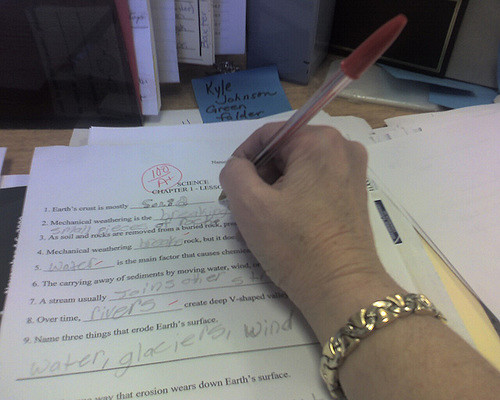How the Other Half Lives: Teachers Dealing With Stress

photo courtesy of Google under the Creative Commons license
Once all the students are gone, silence envelops KHS. Students will head home and begin their mountain of homework, while teachers stay behind creating lesson plans and grading papers. Like their students, teachers go home to find more work awaiting them.
“On a normal weeknight, I easily work an hour more when I’m at home,” Cindy Koehler, French teacher, said. “I don’t leave here at 3:10 p.m. in the afternoon. To me that is just part of the job.”
Sufficient time for her child is not a challenge anymore because her daughter has moved out. Emily, Koehler’s daughter, frequently visits on the weekends, so catching up is not difficult. Koehler’s issue is finding time to spend with her husband during the week. He works at home, so his hours are very flexible, while time restrictions along with grading deadlines fill up Koehler’s life.
“I find it difficult to be in the kitchen grading papers when my husband is sitting by himself watching TV,” Koehler said. “I typically try to grade until no later than 8 p.m. so I can at least go sit and watch a show with him.”
When B.J. Kenyon, history teacher, picks up his daughters from Adventure Club, his race against the clock begins. Unlike Koehler, whose adult daughter lives on her own, Kenyon can not go home and start grading right away. Evenings are full of family time, cooking dinner and putting his kids to bed.
“Once they go to bed at 8:30, then it is back to doing work for school,” Kenyon said. “Where I used to take maybe an hour at night to watch television, I don’t do that anymore.”
Despite his demanding workload outside school, Kenyon finds ways around late nights. He arrives to work at 6 a.m., and leaves at 5 p.m. These long hours give him the time he needs to complete most of his work, leaving less for the evening and night. Although, the necessity of sleep can bring work to a close before all his tasks are completed.
Meanwhile, Molly Stephenson, English teacher, has another family member in need of care. Her mom’s cousin, Alice, who is 96 years old, needs lots of supervision which has been very time consuming for Stephenson. She takes turns watching Alice during the week with her sister, but grading and planning have been taking up less of her time due to Alice’s constant needs.
“You have to be sure you get enough rest,” Stephenson said. “It’s very easy to have all-nighters when you know you have to have something done by a certain time, you might cut your sleep short. That’s dangerous to do.”
To these three teachers, grading is the most stressful task in their career life. According to Koehler grading is a time when she can help her students in a constructive way, despite the stress it induces.
“When stuff happens and I start getting behind and the pile is getting out of control, that stresses me out,” Koehler said. “[I’m stressed] In the sense I have a lot of work to do, but also that I owe [grades] back to the students in a timely fashion.”
Despite long hours and piles of papers to grade, these teachers say they love what they do. The stress is worth it when they know how much it benefits the students.
“The cool thing about teaching is that no day is the same, no class period is the same,” Kenyon said. “You never know what to expect. Sometimes lessons can go great with one class and they can fall flat on their face with another.”
Your donation will support the student journalists of Kirkwood High School. Your contribution will allow us to purchase equipment and cover our annual website hosting costs.

Interests: Reading, being stressed and going to concerts.
Favorite musical artist: Ariana Grande.
Favorite quote: "You have the moral backbone...











